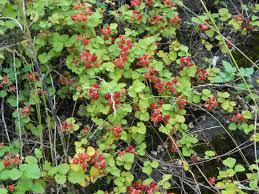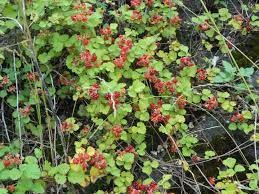Don't forget those familiar weeds
30 Nov 2021
Simone Horn, Land Services Officer
Blackberry, like so many weeds (and more desirable plants) is taking advantage of the favourable seasonal conditions over the past 18 months. And whilst it’s very important for land managers to keep their eye out for emerging weeds, it’s also important for us to keep an eye on those we’re more familiar with – like Blackberry (Rubus spp.). There are a number of Rubus species, but the most common like wetter areas.
Many landholders are reporting that previously controlled patches have returned with vigour and are now presenting a fresh challenge to farm biosecurity and production, and to natural resource management.
Blackberry forms tall, tangled thickets and is a weed that has invaded millions of hectares of land in Australia, so it is a familiar and unwelcome sight to many.
Below are pictures of the fruit and leaves (below left), and a thicket of blackberry (below right).


Blackberry infestations
- Quickly cover large areas
- Shade out or choke out more desirable plants and pasture grasses
- Compete with other plants for moisture and reduce biodiversity
- Restrict access to some areas of land and water for land managers and their stock. For example, stock may not be able to access water due to size of infestation and prickly canes
- Provide food and shelter for introduced species such as rabbits, foxes, blackbirds and starlings. Seed is also distributed over wide areas by birds, foxes and other mammals
- Contribute to increased fire hazard, as large amounts of dead canes and leaf litter develop over time.
Blackberries have a two-year life cycle, which is important to understand in order to effectively control an infestation! Their roots and crown are perennial, but the canes themselves are biennial.
There are an enormous amount of resources available to assist you in tackling this persistent weed, but having a good understanding of the plant’s biology is a great place to start.
Here’s how a blackberry grows
Canes begin to grow in the first year, when they are called primocanes. The primocanes grow in spring and autumn – and when their tips touch the ground, the plant sprouts roots and produces a new bud called daughter plants. The daughter plant will grow into a new first year cane (primocane) the next spring.
In the second year, the plant’s cane grows and produces more leaves, along with flowers (from Nov to Feb) and fruit (from Dec to Apr). This second year growth is called a floricane. After fruiting during the summer/autumn, the floricane stops actively growing and leaves begin to yellow. Blackberry seed falls to the ground, or can be spread by foraging animals such as foxes, cows and birds. New plants can propogate from there.
At any given time, blackberries will have canes in different stages of growth. Leaves on primocanes have mostly 5 leaflets, whilst those on floricanes mostly have three leaflets.
Daughter plants are usually produced close to the tip of the primocane (and this can occur up to 6m from the crown) and the cane tip can then continue to extend after the daughter plant is formed.
Canes that have fruited die back to the crown over autumn and winter and leaves may also be shed during winter. The plant is left with living, year-old, primocanes and daughter plants that are growing independently.
Blackberries also have a secondary root system that can create small buds that detach from the primary root when the crown is under threat – and these buds establish roots in the soil several metres underground.
Blackberry control is therefore a multi-year process. It requires ongoing control and monitoring… and follow up control is key to success!
There are a number of methods that may be used in control – and control with herbicide is one of the most effective methods.
A number of herbicides are registered for the control of blackberry. It is important to note, however, that herbicide users must be suitably trained and only use herbicide in accordance with label instructions. Importantly, when working in or near waterways, where the most common blackberry can be found, only aquatic approved formulations should be used. Spraying herbicide away from the water (ie towards banks) is best practice.
It’s also important that landholders make themselves familiar with a native plant that is sometimes mistaken for blackberry. The Native raspberry (Rubus parvifolius) can be distinguished by their smaller, wrinkled, pinnate leaves (that is, 3-5 toothed leaflets that are arranged along a middle vein) and distinctive pink to red flowers. The red fruit is 1cm wide, whereas the berries on a blackberry are 1-3cm wide.

Further information is available at the NSW Department of Primary Industries website. In particular, see the NSW WeedWise page and the NSW Weed Control Handbook.